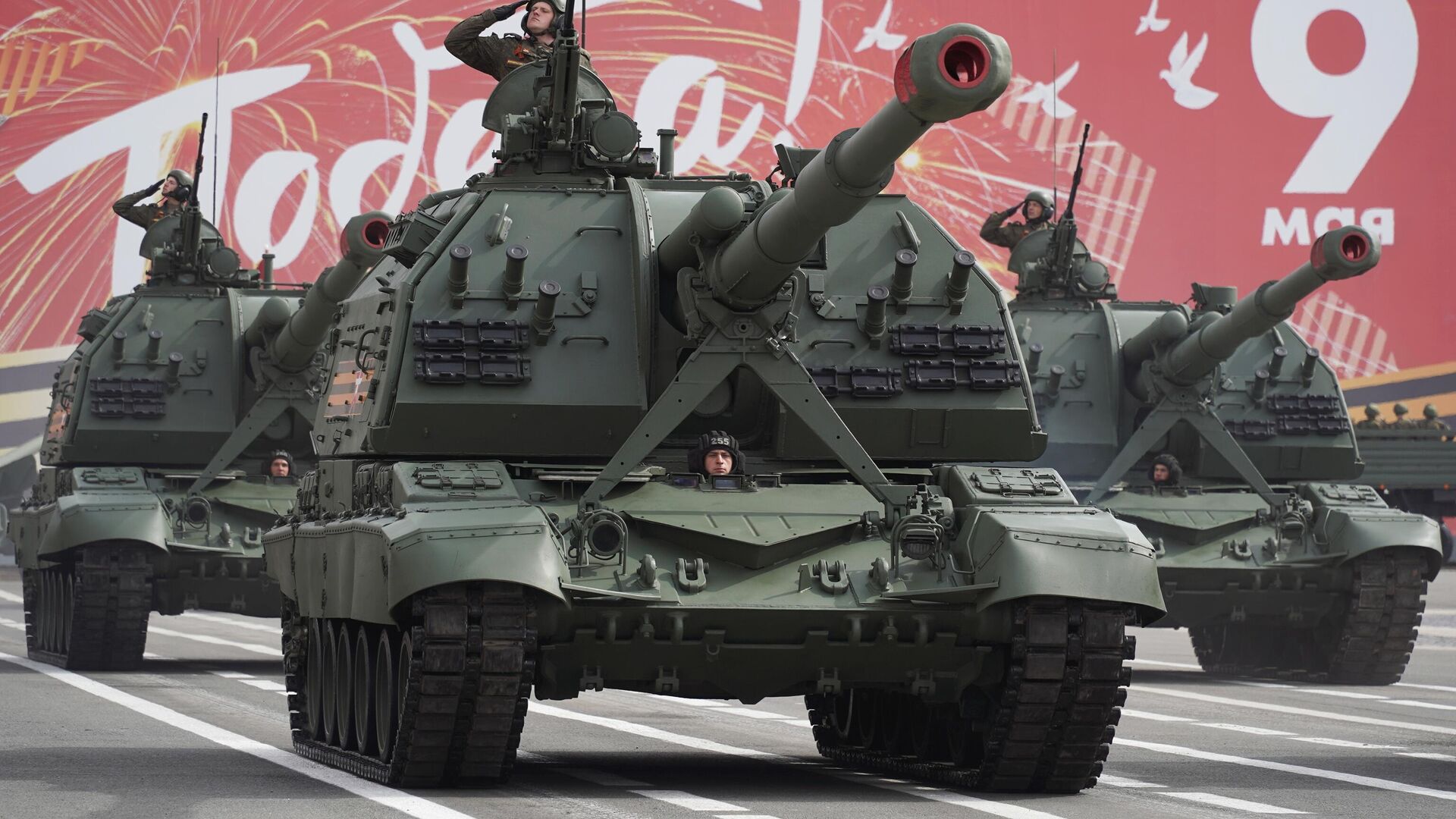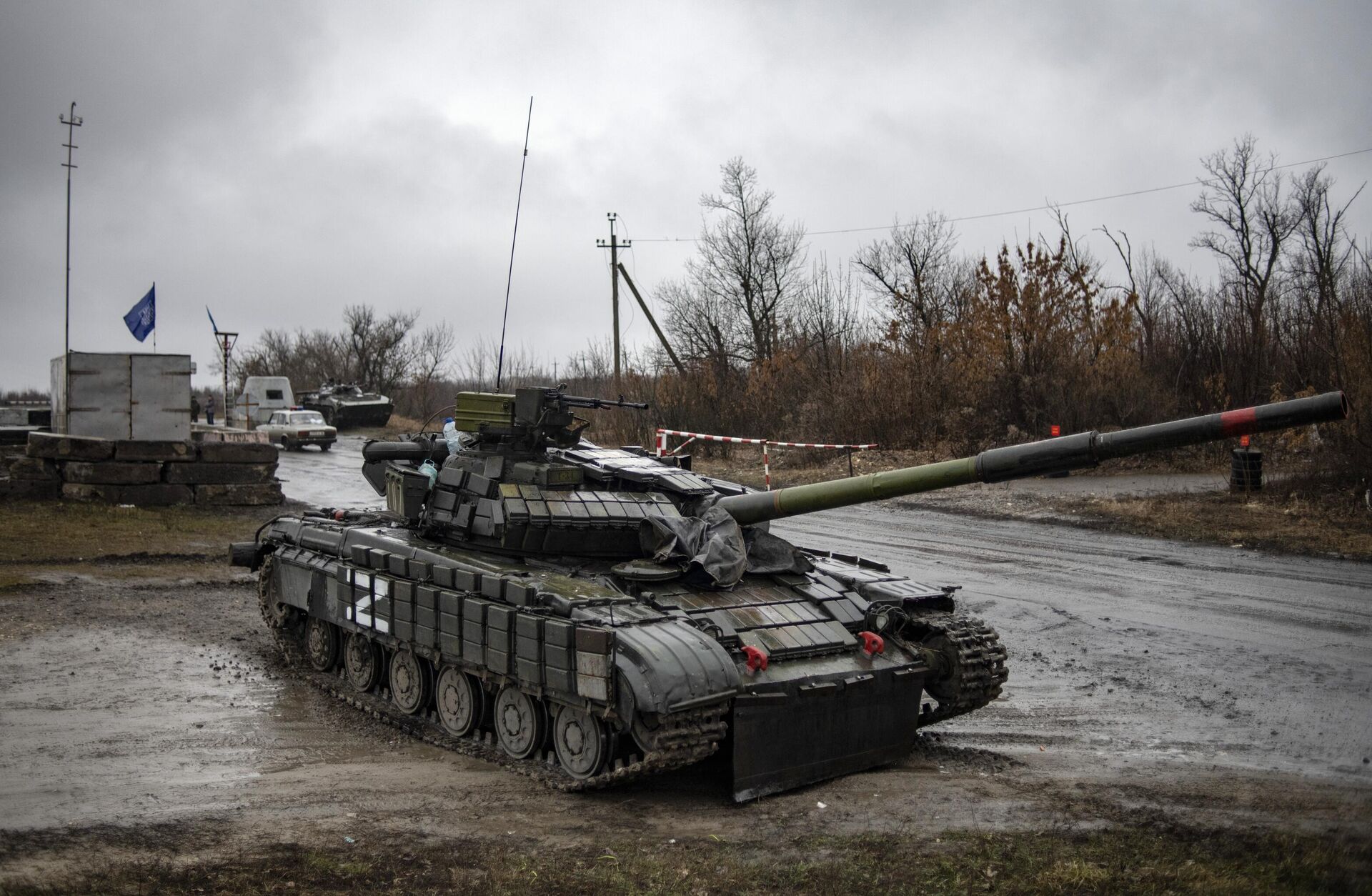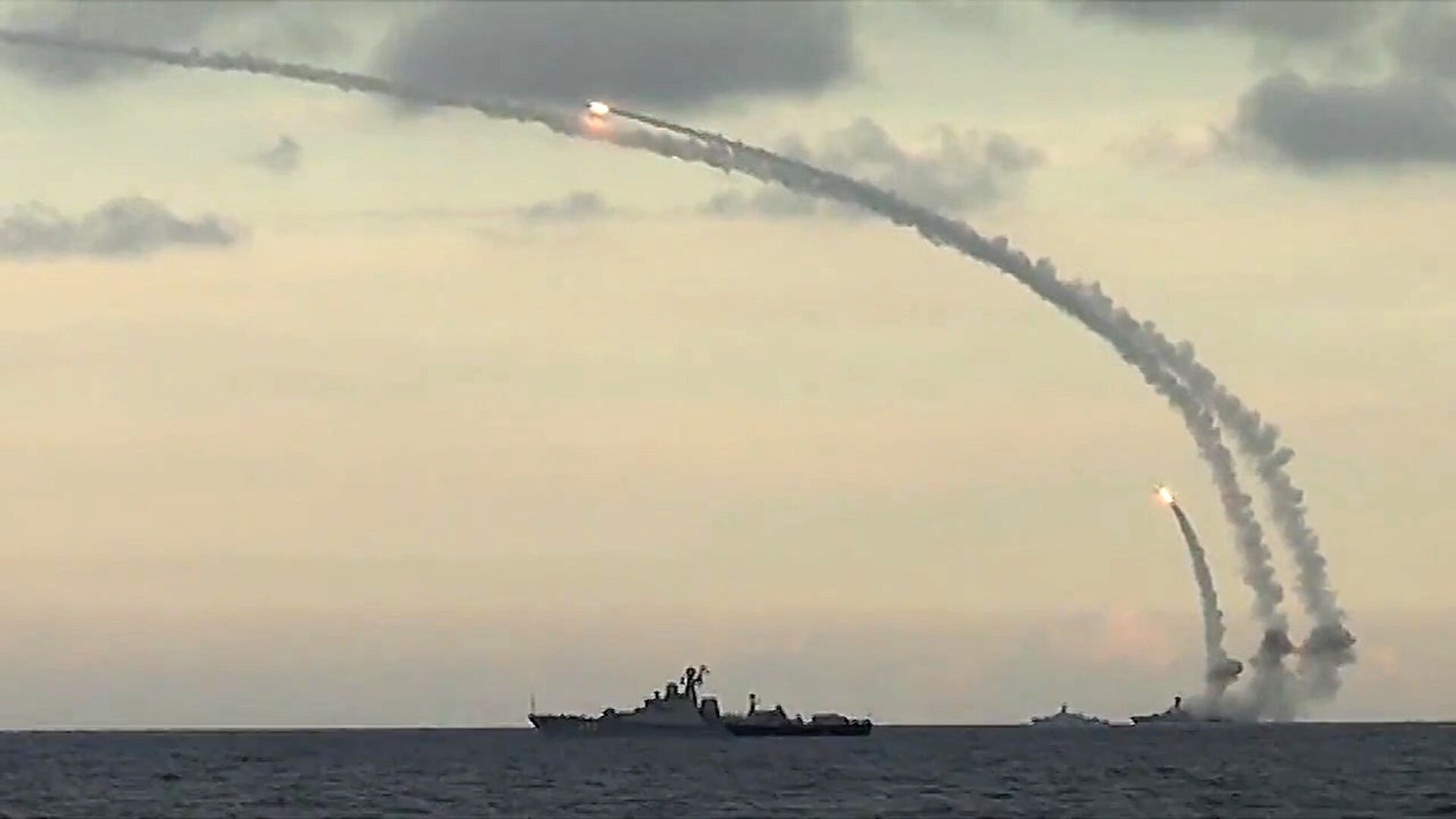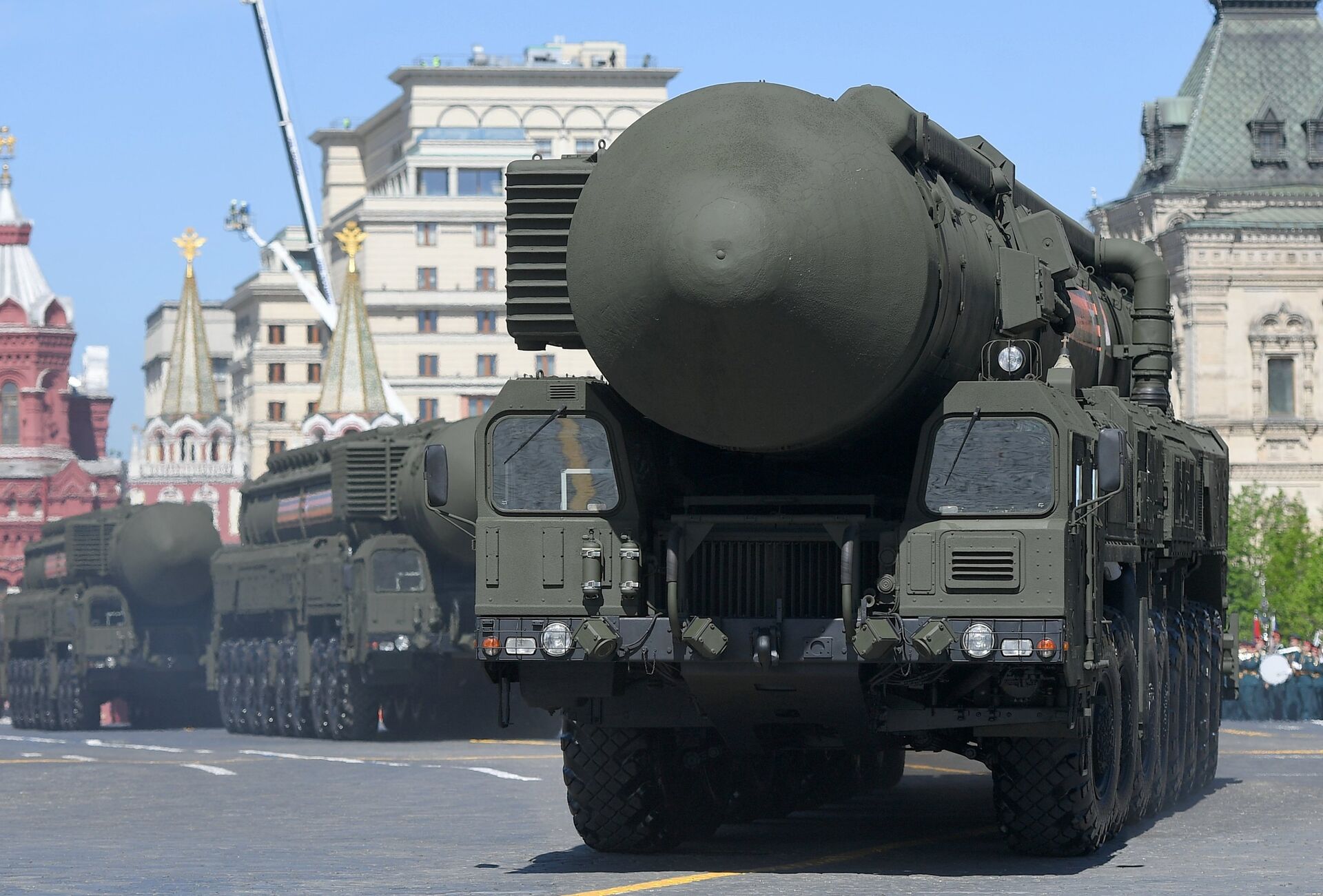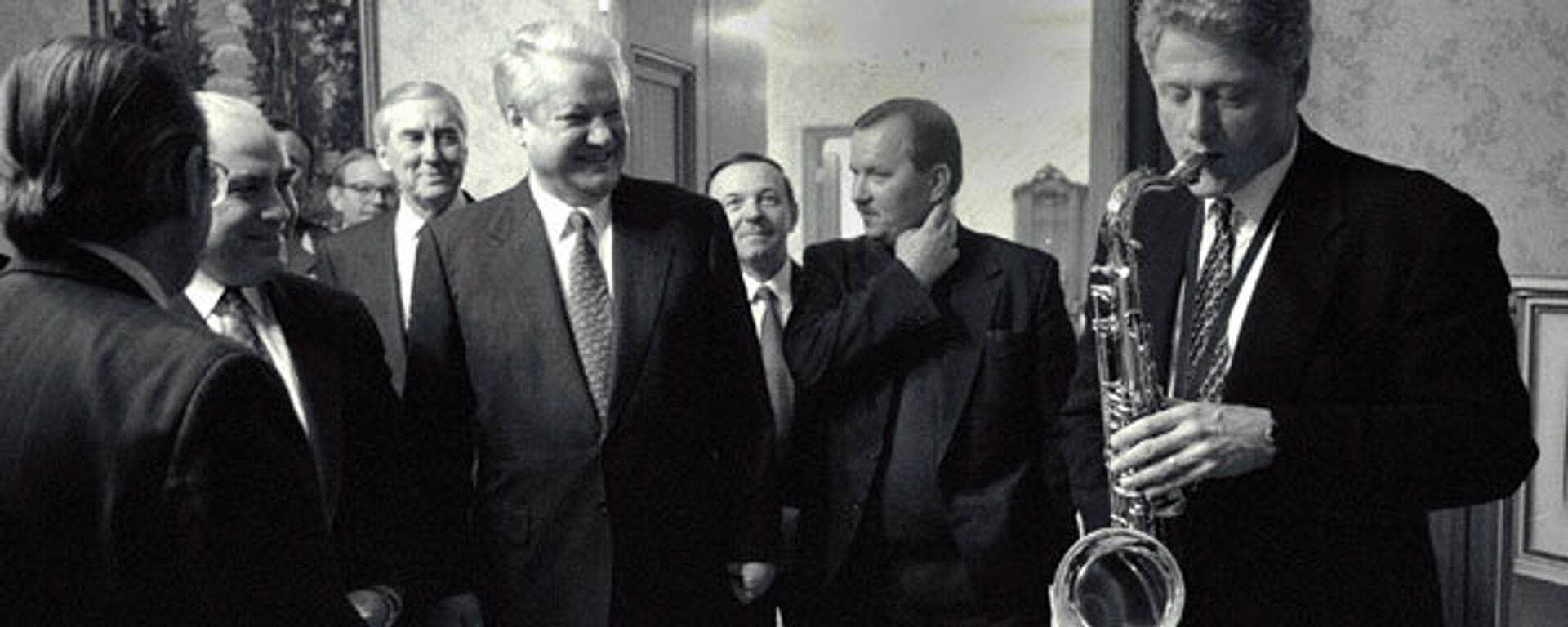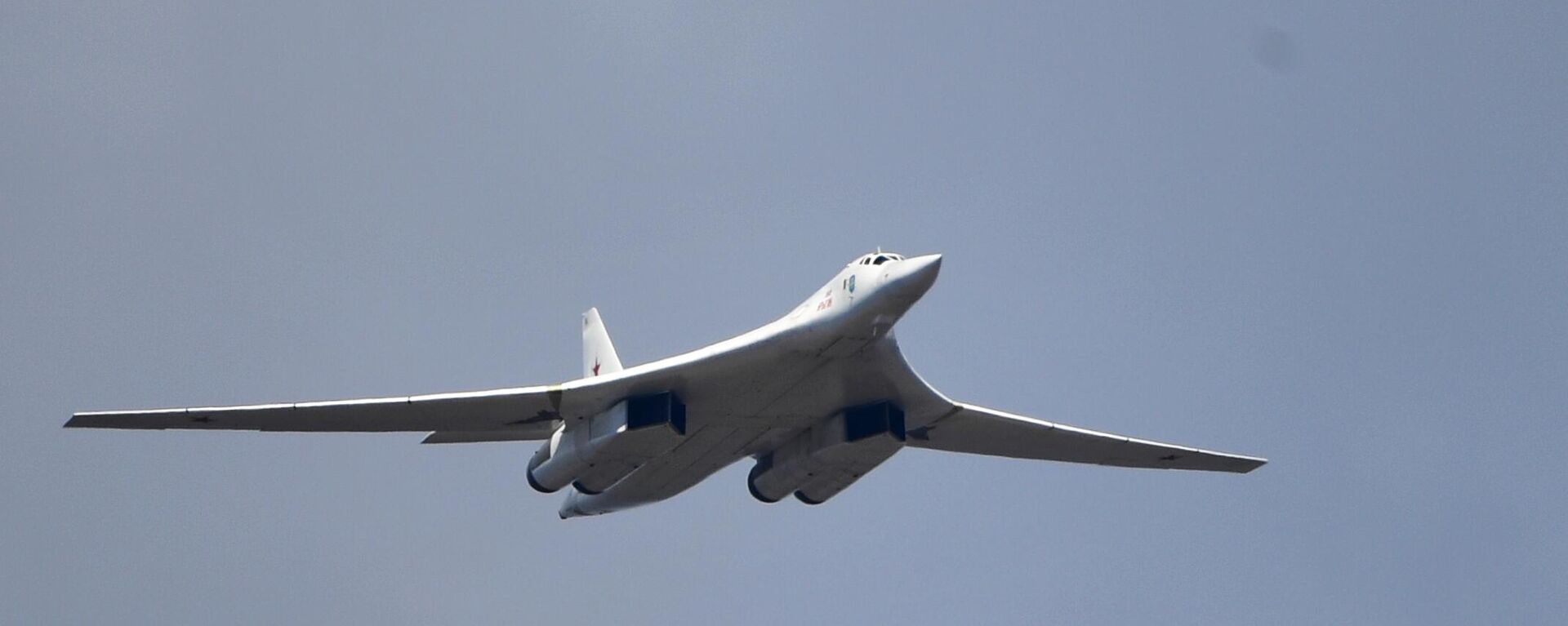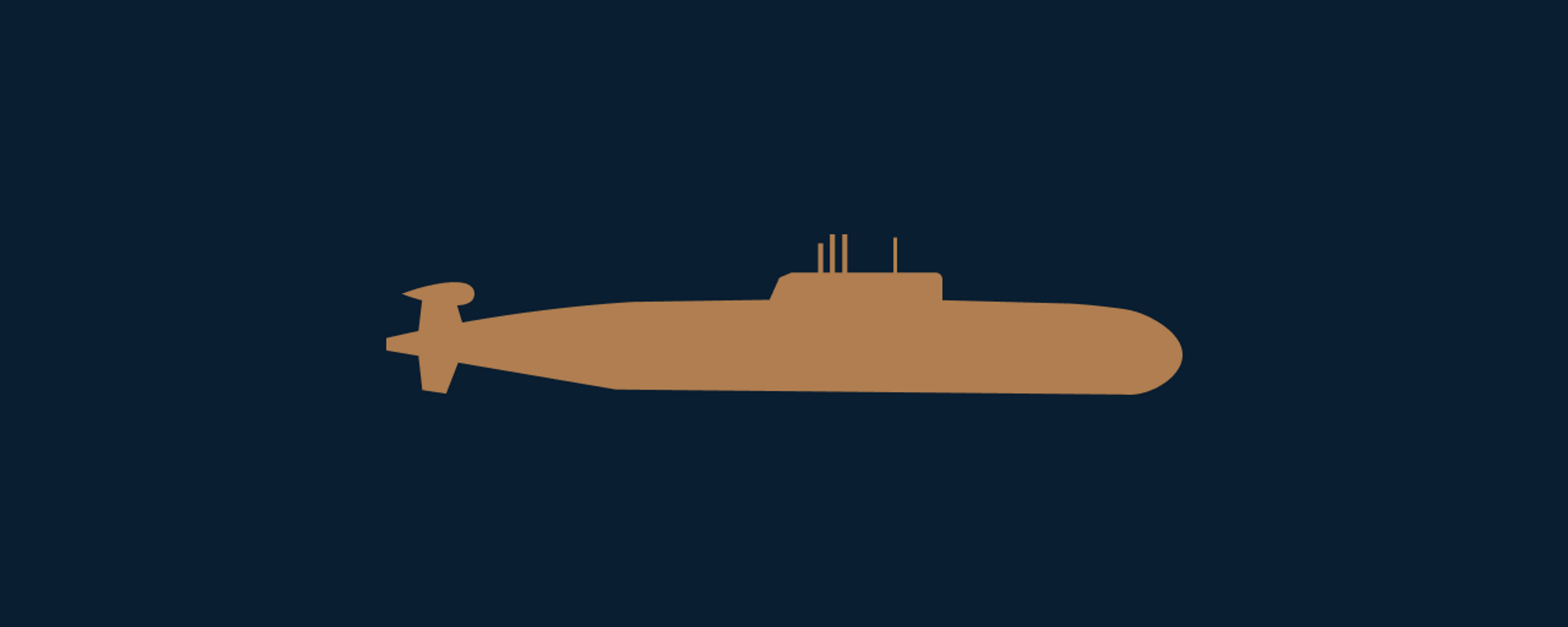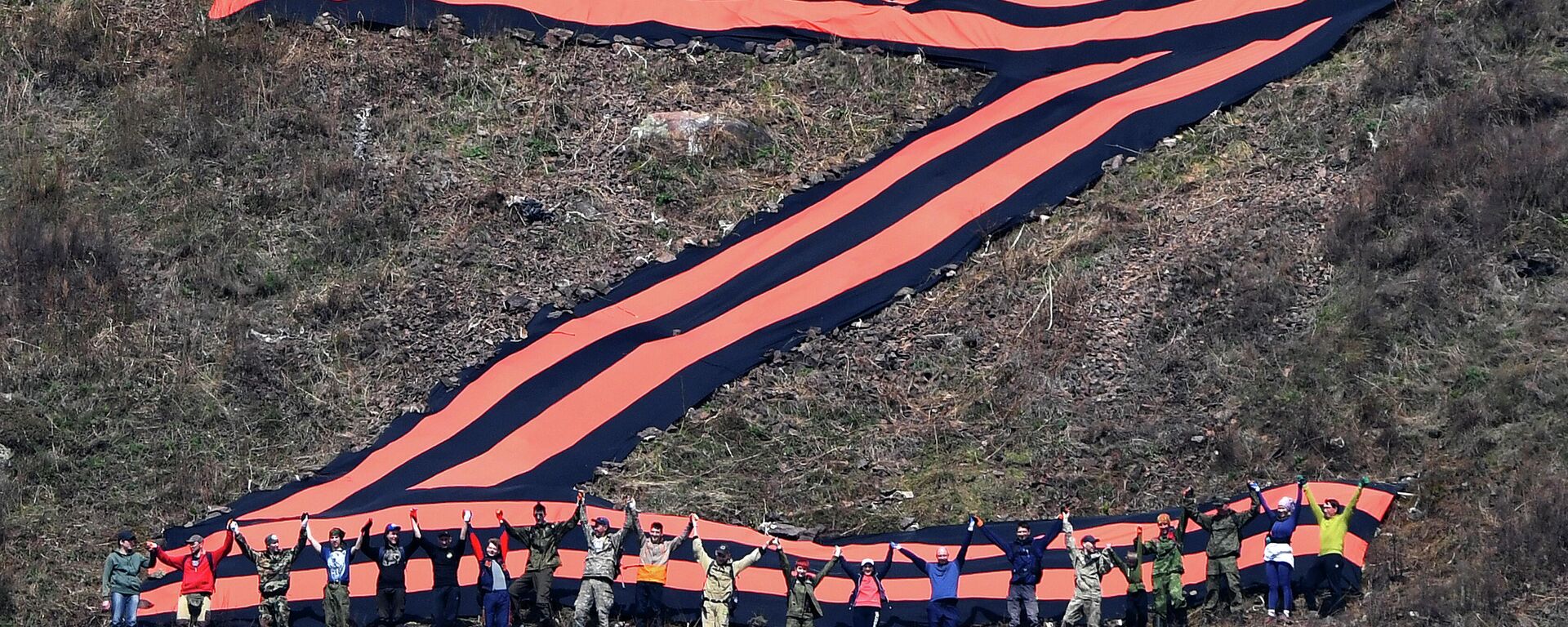https://sputnikglobe.com/20230507/born-in-chaos-forged-in-combat-how-todays-russian-military-structure-came-to-be-1110150149.html
Born in Chaos, Forged in Combat: How Today's Russian Military Structure Came to Be
Born in Chaos, Forged in Combat: How Today's Russian Military Structure Came to Be
Sputnik International
Sunday marks the 31st anniversary of the creation of the modern Russian military. What is its makeup and composition? What does the letter ‘Z’ painted on Russian vehicles in Ukraine mean? How does Russia’s military stack up against NATO? Read Sputnik’s explainer to find out.
2023-05-07T07:00+0000
2023-05-07T07:00+0000
2023-05-07T13:54+0000
military
military
russia
armed forces
boris yeltsin
sergei shoigu
ukraine
nato
russian armed forces
russian navy
https://cdn1.img.sputnikglobe.com/img/07e7/05/06/1110149980_0:160:3072:1888_1920x0_80_0_0_de3e5f75691022dc6704e0f2cd9617b7.jpg
On May 7, 1992, Russia's first president Boris Yeltsin issued an executive order establishing the Russian Armed Forces and assumed control as supreme commander.Rough StartArguably no part of Russian society was impacted more adversely by the collapse of the USSR than the military. In December 1991, over 3.6 million active-duty generals, officers and conscripts who once pledged allegiance to the Soviet Union awoke to find themselves in 15 different countries.“The Air Defense Troops in Estonia have been abandoned and forgotten about. Yeltsin made promises and then reneged on his own words. He has betrayed us,” one officer angrily said at a gathering of the All-Army Officers’ Meeting in Moscow in early 1992. “We’re surviving however we can.”“It’s very difficult to speak about combat readiness today, since soldiers and officers aren’t rotated from combat duty for days on end, and there is no one to replace them for even one day. The Army cannot continue to remain in such condition. I for example am a Ukrainian by nationality, my wife is Russian, our four children were born in the Baltics, Ukraine, Russia and Kazakhstan. I would like to ask the president at this meeting: what country am I a citizen of today? And what country will I live in tomorrow together with my family?” another asked.The Russian military would spend the rest of the 1990s in its most difficult state since the turmoil that followed the 1917 revolutions, facing massive budget cutbacks, severe demoralization, the start of NATO's gradual encroachment toward Russia’s borders, and a series of conflicts across the post-Soviet zone.It wouldn’t be until the appointment of Vladimir Putin as Yeltsin’s successor on December 31, 1999 (and his election as president in 2000) that the Russian military would begin to recover from the wounds, both figurative and literal, that it had received in the 1990s.Sizing Up Russia's Armed ForcesRussia is in the process of expanding the size of its armed forces in connection with the crisis in Ukraine. In December, Defense Minister Sergey Shoigu announced that the military needed to enlarge from around one million troops to one-and-a-half million. “In order to guarantee the fulfillment of tasks to ensure Russia’s security, it’s necessary to increase the strength of the Armed Forces to 1.5 million servicemen, including 695,000 contract servicemen,” Shoigu said.In January, the defense chief held a meeting with his deputy defense ministers and commanders on the implementation of the directive, with the initiative to be completed between 2023 and 2026.On May 2, Shoigu offered an update on the current state of the nation's rearmament program, revealing that the military is purchasing nearly triple the amount of weapons of certain types than it did in 2022, and seven times more of those in particularly high demand. The minister emphasized that the capabilities of the Armed Forces depend on the timely replenishment of weapons, meaning the military industrial complex must keep pace with the increase in demand. “In general, the military industry is meeting the needs of the Army and Navy. However, it’s necessary to identify risks of enterprises failing their obligations and promptly take corrective measures in a timely manner,” he said.The Makeup of Russia's Armed ForcesThe Russian military consists of five service branches:How Big are Russia's Ground Forces?The Russian Ground Forces are by far the biggest branch, accounting for about 550,000 personnel in 2022. These consist of eight motorized rifle divisions, three tank divisions, one machine-gun-artillery division, and about 100 brigades ranging from motorized rifle and tank units to artillery, rocket artillery, control and communications, electronic warfare, air defense, engineering units, military police and the Radiation, Chemical and Biological Defense Troops formations. Troops are divided into Combined Arms Armies located in the Western, Southern, Central and Eastern Military Districts.These forces have thousands of tanks (up to 2,800), infantry fighting vehicles (up to 5,100) and armored personnel carriers (up to 6,100), self-propelled and towed guns (over 1,750), rocket artillery (over 1,350) and surface-to-air missile systems (2,530+), and tens of thousands more tanks, IFVs, APCs, towed and self-propelled guns in storage. Part of these stocks has been tapped to shore up equipment engaged in Ukraine, with the military deploying a potpourri of equipment in the conflict zone, from various modifications of the T-72 tank to the T-80, and from Soviet-era BTR designs to the Tigr infantry vehicles introduced in the 2000s. How Big are Russia's Aerospace Forces?The Russian Aerospace Forces are, as the name suggests, the military branch responsible for assuring the security of Russia’s vast airspace, from the Arctic to the Black and Caspian Seas, and from the Baltic Sea to the Pacific Ocean. The size of the force was about 165,000 in 2020, and they are subdivided between the Air Force, the Air and Missile Defense Forces, and the Space Forces.The main sub-branch, the Air Force, is equipped with a broad array of equipment, from fighter jets and fighter-bombers to heavy strategic bombers, transport and attack helicopters, transport planes, tankers and trainers. Among the best known aircraft are the Sukhoi-Su-34 twin-seat, all-weather fighter-bomber/strike aircraft, single-seat Sukhoi Su-35 air defense fighters, Mil Mi-24 helicopter gunships, Tu-160 'White Swan' strategic bombers and Ilyushin Il-76 jumbo transport planes.The air defense forces are equipped with an array of stationary and mobile radar, air and missile defense equipment, ranging from the stationary A-135 anti-ballistic missile system protecting Moscow from missile attack to road-mobile S-300 and S-400 missile systems. The Space Forces are equipped with tools to assist in space control, and the means to place satellites in orbit.The Aerospace Forces have access to over 100 air bases from the exclave of Kaliningrad in the west to Sakhalin Island in the Far East, as well as several bases abroad, most notably the Khmeimim Air Base in Syria.How Big is Russia's Navy?The Russian Navy consists of about 150,000 personnel, divided into the Baltic, Northern, Black and Pacific Fleets, plus the Caspian Flotilla, the Naval Infantry and Naval Aviation. Headquartered in St. Petersburg, the Russian Navy is the third largest in the world after the United States and China, with its inventory including over 65 attack and missile submarines, 80 corvettes, 60 landing craft, 11 frigates, 10 destroyers, 2 cruisers and 1 aircraft carrier – the Admiral Kuznetsov.Russia is one of only a handful of nations in the world with a so-called blue water navy – which means it can deploy naval assets across the globe in the world’s oceans (hence the term ‘blue’, rather than coastal, or ‘brown’ water). Other countries in the former category include the US, as well as France, Britain, China, Italy and India.The collapse of the USSR forced Russia to significantly scale back its naval ambitions, with the Kuznetsov carrier just one of six sister ships built for the Soviet Navy, which found themselves in various hands after 1991, two of them having been sold to India and China and upgraded and modernized, and one turned into a floating theme park. The never-completed nuclear-powered Ulyanovsk would have allowed Russia to join the exclusive club of countries with supercarriers, but construction was halted in 1991, and scrapped in 1992.Russia has made up for reduced tonnage with a number of asymmetrical solutions, including equipping multiple classes of warships – from small corvettes to stealthy attack subs, with the ability to launch nuclear-capable Kalibr cruise missiles. In 2015, corvettes from the Russian Caspian Flotilla showed off the Kalibr’s capabilities, firing dozens of missiles at terrorist targets in Syria, over 1,500 km away.What Makes Russia's Airborne Forces and Strategic Rocket Forces Special?The Russian Airborne Forces and the Strategic Rocket Forces are special branches of troops. The former consist of about 45,000 personnel, and as the name suggests, are tasked with airborne assault missions, although they can also join ground operations where particularly well-trained, battle-hardened troops are needed. Along with the Special Operations Forces, the Airborne Forces are considered among the most elite units of the Russian military. The Airborne troops are equipped with light armor, including infantry fighting vehicles and the 2S9 Nona, a specially-designed air-droppable self-propelled mortar.The Strategic Rocket Forces carry perhaps the greatest burden on their shoulders among all of Russia’s military personnel – and are responsible for launching the nation’s nuclear weapons in the event of an enemy nuclear attack, or conventional aggression so severe that it threatens the existence of the state, to paraphrase the official nuclear doctrine. About 50,000 personnel serve in the Strategic Rocket Forces.Russia is one of five countries in the world with a nuclear triad – meaning the ability to launch nukes from a silo, or mobile ground-based units, submarines or aircraft. The nuclear triad gives Russia an important psychological guarantee that in the event of an enemy's first strike - even if it’s a massed conventional cruise missile strike designed to decapitate the Russian leadership or neutralize its nukes – at least some of the warheads will get through.Who Commands the Russian Armed Forces?The Russian president is the constitutionally mandated supreme commander in chief of the Russian Armed Forces.What Does the Letter ‘Z’ Mean on Russian Tanks?The appearance of the letter ‘Z’ on Russian armored units during the escalation of tensions in the Donbass in early 2022 has no official military explanation. Most experts speculate that the markings, along with the more rarely observed letters ‘V’ and ‘O’, were painted on vehicles to allow Russian forces to avoid friendly fire, and possibly, to indicate the direction the equipment was supposed to travel –Z for Zapad, or ‘West’, V for Vostok, or ‘East’, or to distinguish between forces from the Western and Eastern military districts. That leaves the mysterious ‘O’. The jury is still out on what that letter may mean.In any event, the letter ‘Z’ has now become the symbol for the military operation in Ukraine as a whole, and used in flags, slapped on vehicles, caps, shirts and other items and even donned by some social media users to show their support for the troops.Is Russia’s Military More Powerful Than NATO’s?Military nerds on internet forums and social media have debated until they’re blue in the face about who would win a conflict between the Russian military and NATO, using arguments ranging from readiness levels to statistics on equipment and ammunition types to combat experience and the ability of economies and military industries to sustain a prolonged conflict. By nearly all military parameters, from total personnel, aircraft and warships, NATO has the edge. The alliance spends significantly more on defense – over $1 trillion in 2022 compared to about $86.4 billion by Moscow. The size of the alliance’s economies is also larger, with a GDP of $18.35 trillion dwarfing Russia’s $1.8 trillion. Of course, raw numbers aren’t everything, with the West’s failed sanctions war showing just how dramatic miscalculations about perceived strength can be, and historical conflicts from Vietnam to Afghanistan demonstrating that grit and determination can count for just as much as or even more than raw power.Whatever the arguments about comparative military power may be, the figures above certainly serve to validate Russia’s concerns about NATO’s eastward creep over the past two-and-a-half decades. Hopefully, theories about ‘which side is stronger’ will never have to be put to the test, because the fate of billions of lives, and perhaps even humanity itself, may depend on peace between the nuclear superpowers.
https://sputnikglobe.com/20180319/documents-nato-russia-yeltsin-expansion-1062700616.html
https://sputnikglobe.com/20230428/shoigu-us-allies-implementing-plan-to-provoke-other-countries-to-confrontation-with-russia-china-1109908961.html
https://sputnikglobe.com/20230426/watch-russias-tu-160s-flying-over-neutral-waters-of-barents-norwegian-seas-1109843717.html
https://sputnikglobe.com/20230410/belgorod-nuclear-submarine-armed-with-poseidon-torpedoes-1109325885.html
https://sputnikglobe.com/20220430/russian-esports-team-disqualified-from-dota-tournament-for-z-symbol-1095166780.html
https://sputnikglobe.com/20230323/west-bringing-world-to-dangerous-line-beyond-which-there-is-nuclear-armageddon---antonov-1108707289.html
russia
ukraine
Sputnik International
feedback@sputniknews.com
+74956456601
MIA „Rossiya Segodnya“
2023
News
en_EN
Sputnik International
feedback@sputniknews.com
+74956456601
MIA „Rossiya Segodnya“
What’s the Makeup of Modern Russia’s Armed Forces?
Sputnik International
What’s the Makeup of Modern Russia’s Armed Forces?
2023-05-07T07:00+0000
true
PT1M00S
Sputnik International
feedback@sputniknews.com
+74956456601
MIA „Rossiya Segodnya“
russian armed forces, russian army, russian armed forces equipment, russian armed forces size, russian armed forces ranks, russian armed forces uniforms, russian armed forces numbers, russian armed forces, russian military strength, russian military power vs american military power, russian forces in syria, russian military forces, russian ground forces, russian aerospace forces, russian air force, russian navy, how many russian navy ships, how many submarines does russia have
russian armed forces, russian army, russian armed forces equipment, russian armed forces size, russian armed forces ranks, russian armed forces uniforms, russian armed forces numbers, russian armed forces, russian military strength, russian military power vs american military power, russian forces in syria, russian military forces, russian ground forces, russian aerospace forces, russian air force, russian navy, how many russian navy ships, how many submarines does russia have
On May 7, 1992, Russia's first president Boris Yeltsin issued an executive order establishing the Russian Armed Forces and assumed control as supreme commander.
Arguably no part of Russian society was impacted more adversely by the collapse of the USSR than the military. In December 1991, over 3.6 million active-duty generals, officers and conscripts who once pledged allegiance to the Soviet Union awoke to find themselves in 15 different countries.
“The Air Defense Troops in Estonia have been abandoned and forgotten about. Yeltsin made promises and then reneged on his own words. He has betrayed us,” one officer angrily
said at a
gathering of the All-Army Officers’ Meeting in Moscow in early 1992. “We’re surviving however we can.”
“It’s very difficult to speak about combat readiness today, since soldiers and officers aren’t rotated from combat duty for days on end, and there is no one to replace them for even one day. The Army cannot continue to remain in such condition. I for example am a Ukrainian by nationality, my wife is Russian, our four children were born in the Baltics, Ukraine, Russia and Kazakhstan. I would like to ask the president at this meeting: what country am I a citizen of today? And what country will I live in tomorrow together with my family?” another asked.
“[We’re told] by our media that nobody is threatening us and that we are living in new world of ‘common human thinking’, that these tendencies are victorious. But we see what happened to Iraq, which dared to act in a way that the United States didn’t want, what happened to Grenada, and to Panama and its duly elected president, who was extradited and stood trial. The Americans aren’t reducing their military presence in the Indian Ocean, in the Mediterranean Sea, in the Pacific Ocean, but our ships, speaking frankly, if the current trend continues, will be left laid up at harbors,” a concerned naval officer said.
The Russian military would spend the rest of the 1990s in its most difficult state since the turmoil that followed the 1917 revolutions, facing massive budget cutbacks, severe demoralization, the start of NATO's gradual encroachment toward Russia’s borders, and a series of conflicts across the post-Soviet zone.
It wouldn’t be until the appointment of Vladimir Putin as Yeltsin’s successor on December 31, 1999 (and his election as president in 2000) that the Russian military would begin to recover from the wounds, both figurative and literal, that it had received in the 1990s.
Today, the Russian Armed Forces rank among the top three military powers in the world, demonstrating over the past year that they are able to wage a proxy war with what is essentially the combined military and economic might of NATO in its entirety in Ukraine.
Sizing Up Russia's Armed Forces
Russia is in the process of expanding the size of its armed forces in connection with the crisis in Ukraine. In December, Defense Minister Sergey Shoigu announced that the military needed to enlarge from around one million troops to one-and-a-half million. “In order to guarantee the fulfillment of tasks to ensure Russia’s security, it’s necessary to increase the strength of the Armed Forces to 1.5 million servicemen, including 695,000 contract servicemen,” Shoigu said.
In January, the defense chief held a meeting with his deputy defense ministers and commanders on the implementation of the directive, with the initiative to be completed between 2023 and 2026.
On May 2, Shoigu offered an update on the current state of the nation's rearmament program, revealing that the military is purchasing nearly triple the amount of weapons of certain types than it did in 2022, and seven times more of those in particularly high demand. The minister emphasized that the capabilities of the Armed Forces depend on the timely replenishment of weapons, meaning the military industrial complex must keep pace with the increase in demand. “In general, the military industry is meeting the needs of the Army and Navy. However, it’s necessary to identify risks of enterprises failing their obligations and promptly take corrective measures in a timely manner,” he said.
The Makeup of Russia's Armed Forces
The Russian military consists of five service branches:
and the Strategic Rocket Forces.
How Big are Russia's Ground Forces?
The Russian Ground Forces are by far the biggest branch, accounting for about 550,000 personnel in 2022. These consist of eight motorized rifle divisions, three tank divisions, one machine-gun-artillery division, and about 100 brigades ranging from motorized rifle and tank units to artillery, rocket artillery, control and communications, electronic warfare, air defense, engineering units, military police and the Radiation, Chemical and Biological Defense Troops formations. Troops are divided into Combined Arms Armies located in the Western, Southern, Central and Eastern Military Districts.
These forces have thousands of tanks (up to 2,800), infantry fighting vehicles (up to 5,100) and armored personnel carriers (up to 6,100), self-propelled and towed guns (over 1,750), rocket artillery (over 1,350) and surface-to-air missile systems (2,530+), and tens of thousands more tanks, IFVs, APCs, towed and self-propelled guns in storage. Part of these stocks has been tapped to shore up equipment engaged in Ukraine, with the military deploying a potpourri of equipment in the conflict zone, from various modifications of the T-72 tank to the T-80, and from Soviet-era BTR designs to the Tigr infantry vehicles introduced in the 2000s.
How Big are Russia's Aerospace Forces?
The Russian Aerospace Forces are, as the name suggests, the military branch responsible for assuring the security of Russia’s vast airspace, from the Arctic to the Black and Caspian Seas, and from the Baltic Sea to the Pacific Ocean. The size of the force was about 165,000 in 2020, and they are subdivided between the Air Force, the Air and Missile Defense Forces, and the Space Forces.
The main sub-branch, the Air Force, is equipped with a broad array of equipment, from fighter jets and fighter-bombers to heavy strategic bombers, transport and attack helicopters, transport planes, tankers and trainers. Among the best known aircraft are the Sukhoi-Su-34 twin-seat, all-weather fighter-bomber/strike aircraft, single-seat Sukhoi Su-35 air defense fighters, Mil Mi-24 helicopter gunships, Tu-160 'White Swan' strategic bombers and Ilyushin Il-76 jumbo transport planes.
The air defense forces are equipped with an array of stationary and mobile radar, air and missile defense equipment, ranging from the stationary A-135 anti-ballistic missile system protecting Moscow from missile attack to road-mobile S-300 and S-400 missile systems. The Space Forces are equipped with tools to assist in space control, and the means to place satellites in orbit.
The Aerospace Forces have access to over 100 air bases from the exclave of Kaliningrad in the west to Sakhalin Island in the Far East, as well as several bases abroad, most notably the Khmeimim Air Base in Syria.
How Big is Russia's Navy?
The Russian Navy consists of about 150,000 personnel, divided into the Baltic, Northern, Black and Pacific Fleets, plus the Caspian Flotilla, the Naval Infantry and Naval Aviation. Headquartered in St. Petersburg, the Russian Navy is the third largest in the world after the United States and China, with its inventory including over 65 attack and missile submarines, 80 corvettes, 60 landing craft, 11 frigates, 10 destroyers, 2 cruisers and 1 aircraft carrier – the Admiral Kuznetsov.
Russia is one of only a handful of nations in the world with a so-called blue water navy – which means it can deploy naval assets across the globe in the world’s oceans (hence the term ‘blue’, rather than coastal, or ‘brown’ water). Other countries in the former category include the US, as well as France, Britain, China, Italy and India.
The collapse of the USSR forced Russia to significantly scale back its naval ambitions, with the Kuznetsov carrier just one of six sister ships built for the Soviet Navy, which found themselves in various hands after 1991, two of them having been sold to India and China and upgraded and modernized, and one turned into a floating theme park. The never-completed nuclear-powered Ulyanovsk would have allowed Russia to join the exclusive club of countries with supercarriers, but construction was halted in 1991, and scrapped in 1992.
Russia has made up for reduced tonnage with a number of asymmetrical solutions, including equipping multiple classes of warships – from small corvettes to stealthy attack subs, with the ability to launch nuclear-capable Kalibr cruise missiles. In 2015, corvettes from the Russian Caspian Flotilla showed off the Kalibr’s capabilities, firing dozens of missiles at terrorist targets in Syria, over 1,500 km away.
What Makes Russia's Airborne Forces and Strategic Rocket Forces Special?
The Russian Airborne Forces and the Strategic Rocket Forces are special branches of troops. The former consist of about 45,000 personnel, and as the name suggests, are tasked with airborne assault missions, although they can also join ground operations where particularly well-trained, battle-hardened troops are needed. Along with the Special Operations Forces, the Airborne Forces are considered among the most elite units of the Russian military. The Airborne troops are equipped with light armor, including infantry fighting vehicles and the 2S9 Nona, a specially-designed air-droppable self-propelled mortar.
The Strategic Rocket Forces carry perhaps the greatest burden on their shoulders among all of Russia’s military personnel – and are responsible for launching the nation’s nuclear weapons in the event of an enemy nuclear attack, or conventional aggression so severe that it threatens the existence of the state, to paraphrase the
official nuclear doctrine. About 50,000 personnel serve in the Strategic Rocket Forces.
Russia is one of five countries in the world with a nuclear triad – meaning the ability to launch nukes from a silo, or mobile ground-based units, submarines or aircraft. The nuclear triad gives Russia an important psychological guarantee that in the event of an enemy's first strike - even if it’s a massed conventional cruise missile strike designed to decapitate the Russian leadership or neutralize its nukes – at least some of the warheads will get through.
The conflict in Ukraine has generated a lot of noise from Western officials and media about the possibility of Russia using tactical nukes in Ukraine. But unless and until Russia’s doctrine is changed to say otherwise, NATO – and specifically its leader – the US, will remain the only nuclear superpower whose doctrine allows for nukes to be used preemptively, and against non-nuclear armed adversaries.
Who Commands the Russian Armed Forces?
The Russian president is the constitutionally mandated supreme commander in chief of the Russian Armed Forces.
What Does the Letter ‘Z’ Mean on Russian Tanks?
The appearance of the
letter ‘Z’ on Russian armored units during the escalation of tensions in the Donbass in early 2022 has no official military explanation. Most experts speculate that the markings, along with the more rarely observed letters ‘V’ and ‘O’, were painted on vehicles to allow Russian forces to avoid friendly fire, and possibly, to indicate the direction the equipment was supposed to travel –Z for Zapad, or ‘West’, V for Vostok, or ‘East’, or to distinguish between forces from the Western and Eastern military districts. That leaves the mysterious ‘O’. The jury is still out on what that letter may mean.
In any event, the letter ‘Z’ has now become the symbol for the military operation in Ukraine as a whole, and used in flags, slapped on vehicles, caps, shirts and other items and even donned by some social media users to show their support for the troops.
Is Russia’s Military More Powerful Than NATO’s?
Military nerds on internet forums and social media have debated until they’re blue in the face about who would win a conflict between the Russian military and NATO, using arguments ranging from readiness levels to statistics on equipment and ammunition types to combat experience and the ability of economies and military industries to sustain a prolonged conflict. By nearly all military parameters, from total personnel, aircraft and warships, NATO has the edge. The alliance spends significantly more on defense –
over $1 trillion in 2022 compared to about $86.4 billion by Moscow. The size of the alliance’s economies is also larger, with a GDP of $18.35 trillion dwarfing Russia’s $1.8 trillion. Of course, raw numbers aren’t everything, with the West’s failed sanctions war showing just how dramatic miscalculations about perceived strength can be, and historical conflicts from Vietnam to Afghanistan demonstrating that grit and determination can count for just as much as or even more than raw power.
Whatever the arguments about comparative military power may be, the figures above certainly serve to validate Russia’s concerns about NATO’s eastward creep over the past two-and-a-half decades. Hopefully, theories about ‘which side is stronger’ will never have to be put to the test, because the fate of billions of lives, and perhaps even humanity itself, may depend on peace between the nuclear superpowers.
